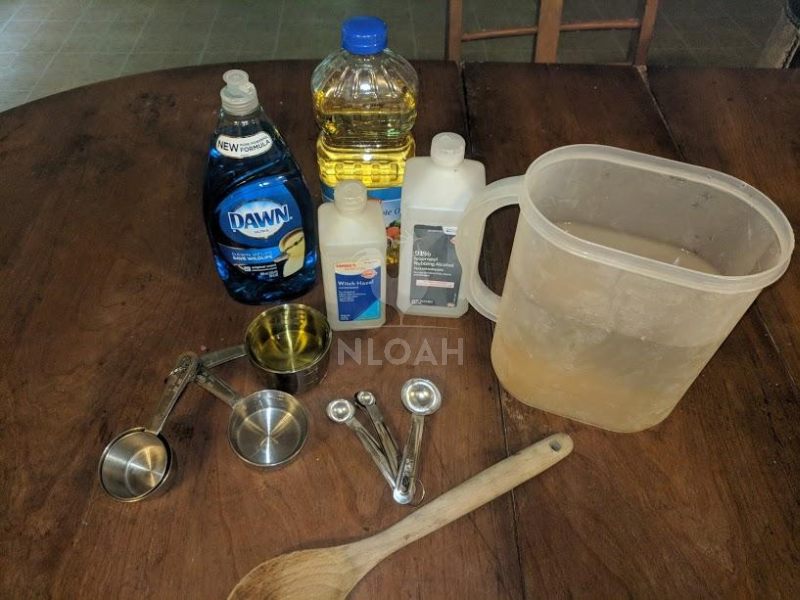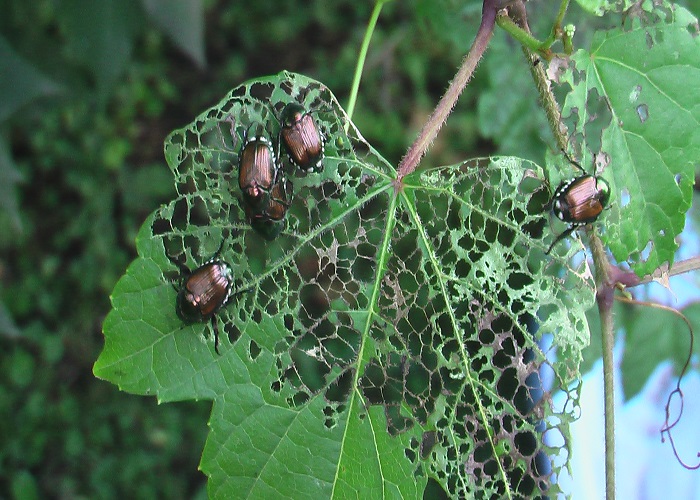Homemade Japanese beetle spray offers a natural and effective way to combat these pesky insects, which can wreak havoc on your garden. These beetles are known for their voracious appetites, devouring leaves and flowers, leaving behind unsightly damage. While chemical pesticides can be effective, they can also harm beneficial insects and pollute the environment. Homemade sprays, on the other hand, provide a safe and environmentally friendly alternative.
This guide explores the science behind homemade Japanese beetle sprays, providing recipes, application techniques, and essential tips for success. We’ll delve into the ingredients, their effectiveness, and safety considerations. By understanding the principles behind these sprays, you can create a customized solution that effectively protects your garden without harming the environment.
Introduction to Japanese Beetles

Japanese beetles are a destructive invasive species that have wreaked havoc on landscapes and gardens across the United States. These metallic green beetles with copper-brown wing covers are a common sight during the summer months, and their presence can quickly turn a lush garden into a defoliated wasteland.
Life Cycle of Japanese Beetles
The life cycle of the Japanese beetle is fascinating and complex. It begins with the egg stage, which is laid in the soil, usually near the base of a host plant. The eggs hatch into white grubs that feed on plant roots. After several weeks, the grubs pupate in the soil, emerging as adults in late spring or early summer. Adult Japanese beetles are active for about 30 to 45 days, during which time they feed on leaves, flowers, and fruits.
Damage Caused by Japanese Beetles
Japanese beetles are notorious for their voracious appetites. Adult beetles feed on the leaves, flowers, and fruits of over 300 different plant species. Their feeding damage is characterized by skeletonization, which occurs when the beetles eat all the leaf tissue except for the veins. This feeding behavior can significantly weaken and even kill plants.
Environmental Impact of Japanese Beetle Infestations
Japanese beetle infestations can have a significant environmental impact. The grubs can damage lawns and other turf grasses, while the adults can defoliate trees and shrubs, reducing their aesthetic value and potentially impacting their health. Additionally, the beetles can spread diseases and pests, further damaging the environment.
Homemade Spray Ingredients
While commercial insecticides are available, many gardeners prefer to use homemade sprays to control Japanese beetles. These sprays often utilize natural ingredients found around the home, offering a more environmentally friendly approach to pest management. It’s crucial to remember that homemade sprays may not be as effective as commercially available products, and multiple applications might be needed for optimal results.
Common Household Ingredients for Japanese Beetle Sprays
Several common household ingredients can be used to create homemade Japanese beetle sprays. These ingredients often work by repelling the beetles or disrupting their feeding habits.
- Dish Soap: Dish soap acts as a surfactant, breaking the surface tension of water and allowing the spray to adhere better to the beetle’s body. It can also disrupt the beetle’s exoskeleton, leading to dehydration.
- Garlic: Garlic contains allicin, a compound that repels insects, including Japanese beetles. Garlic can be added to the spray mixture by crushing cloves and adding them to the water, or by using garlic extract.
- Cayenne Pepper: Cayenne pepper contains capsaicin, a compound that irritates insects and can deter them from feeding. It can be added to the spray mixture by grinding the pepper into a fine powder and adding it to the water.
- Neem Oil: Neem oil is extracted from the neem tree and is known for its insecticidal properties. It disrupts the beetle’s feeding and reproduction, making it an effective control agent.
- Vegetable Oil: Vegetable oil can be used to suffocate Japanese beetles by coating their bodies and blocking their breathing pores. However, it is important to use a small amount of oil to avoid harming plants.
Safety Precautions for Handling and Using Homemade Sprays
While many homemade spray ingredients are considered safe, it is crucial to take precautions when handling and using them. Always wear gloves and protective eyewear to avoid contact with the ingredients. Ensure proper ventilation when mixing and applying the spray. Avoid spraying near food or water sources. Store the spray in a sealed container, out of reach of children and pets.
Recipe Variations: Homemade Japanese Beetle Spray
While the basic recipe for a homemade Japanese beetle spray is relatively straightforward, there are several variations that can be explored, each with its own advantages and disadvantages. The effectiveness of these variations depends on factors such as the severity of the infestation, the specific type of plants being treated, and personal preferences.
Recipe Variations and Their Effectiveness
Here’s a table comparing various homemade Japanese beetle spray recipes, highlighting their ingredients, proportions, application methods, and effectiveness:
| Recipe Name | Ingredients | Proportions | Application Method | Effectiveness |
|---|---|---|---|---|
| Dish Soap and Water | Dish soap, water | 1-2 tablespoons dish soap per gallon of water | Spray directly onto beetles | Moderately effective for small infestations. |
| Garlic Spray | Garlic cloves, water | Crush 4-5 garlic cloves and steep in 1 quart of water for 24 hours. Strain and dilute with water. | Spray directly onto plants | May deter beetles, but effectiveness is inconsistent. |
| Neem Oil Spray | Neem oil, water, dish soap | 1-2 tablespoons neem oil, 1 teaspoon dish soap per gallon of water | Spray directly onto plants | Effective against beetles and other pests, but can be harmful to beneficial insects. |
| Peppermint Oil Spray | Peppermint oil, water, dish soap | 1-2 tablespoons peppermint oil, 1 teaspoon dish soap per gallon of water | Spray directly onto plants | May deter beetles, but effectiveness is inconsistent. |
These recipes offer a range of options for tackling Japanese beetle infestations. Some recipes, like the dish soap and water spray, are simple and cost-effective but may have limited effectiveness. Others, like neem oil spray, can be more potent but may have environmental concerns. It’s important to weigh the pros and cons of each recipe before choosing one.
Homemade Japanese beetle spray is a great way to protect your garden from these pesky insects. If you’re looking for a thoughtful DIY Mother’s Day gift, why not try making a batch of this spray for your mom? DIY Mother’s Day gift ideas can be found online, and this is a practical and eco-friendly option.
With a little time and effort, you can create a homemade Japanese beetle spray that will keep your garden healthy and beautiful all season long.
Recipe Comparison
The following table compares the pros and cons of each recipe in terms of effectiveness, cost, and environmental impact:
| Recipe Name | Pros | Cons |
|---|---|---|
| Dish Soap and Water | Simple, cost-effective, readily available ingredients. | Limited effectiveness, can harm beneficial insects. |
| Garlic Spray | Natural, may deter beetles, safe for beneficial insects. | Effectiveness is inconsistent, requires preparation time. |
| Neem Oil Spray | Effective against beetles and other pests, readily available. | Can be harmful to beneficial insects, may require repeated applications. |
| Peppermint Oil Spray | Natural, may deter beetles, safe for beneficial insects. | Effectiveness is inconsistent, requires preparation time. |
Application Techniques

Applying your homemade Japanese beetle spray is crucial for effective control. The method you choose will depend on the size of your garden and the severity of the infestation. However, there are some general guidelines to follow for optimal results.
Timing and Frequency of Application
The timing and frequency of application are essential for maximizing the effectiveness of your homemade spray. Japanese beetles are most active during the day, so applying the spray in the morning or evening when they are feeding will be most effective. The ideal time to apply the spray is when the beetles are actively feeding on plants, usually in the morning or late afternoon. This will ensure that the spray comes into direct contact with the beetles and prevents them from spreading to other plants.
- Early morning application is ideal as the beetles are usually feeding actively after a cool night.
- Evening application is also effective as the beetles are feeding again before settling down for the night.
- Avoid applying the spray during the hottest part of the day, as the spray may evaporate too quickly and be less effective.
- Apply the spray every 3-5 days, especially during peak beetle activity periods, to maintain control.
Spraying Techniques
Applying the spray properly is crucial for maximizing its effectiveness.
- Directly spray the beetles with the solution, aiming for the underside of their bodies where they are most vulnerable.
- Thoroughly coat the leaves and stems of plants where beetles are present. This will prevent them from feeding and laying eggs.
- Use a fine mist setting on your sprayer to avoid damaging delicate plants.
- Apply the spray in the early morning or late evening when the beetles are most active and feeding.
Maximizing Spray Effectiveness
Here are some tips to maximize the effectiveness of your homemade spray:
- Apply the spray on a windless day to prevent it from drifting onto other plants.
- Avoid spraying the spray on edible plants, especially shortly before harvest.
- Consider combining your homemade spray with other control methods, such as handpicking beetles or using traps.
- Use a sprayer that produces a fine mist to ensure even coverage.
- Apply the spray in the early morning or late evening when the beetles are most active.
Other Control Methods
While homemade sprays can be an effective way to manage Japanese beetle populations, they are not the only solution. There are a variety of other control methods available, each with its own set of advantages and disadvantages.
Hand-Picking
Hand-picking is a labor-intensive but effective method for controlling Japanese beetles. Simply collect the beetles from your plants and drop them into a bucket of soapy water. This method is particularly effective for small infestations or when targeting specific plants.
- Pros: Hand-picking is a non-toxic and environmentally friendly method. It can be very effective at reducing beetle populations, especially when done consistently.
- Cons: Hand-picking can be time-consuming and tedious, especially for large infestations. It may also be difficult to reach all the beetles on tall plants or in dense foliage.
Traps, Homemade japanese beetle spray
Japanese beetle traps use pheromones to attract beetles. These traps typically contain a sticky substance that traps the beetles. Traps can be effective at reducing beetle populations, but they can also attract more beetles to your garden.
- Pros: Traps are relatively easy to set up and maintain. They can be effective at attracting and trapping large numbers of beetles.
- Cons: Traps can attract more beetles to your garden, potentially increasing the overall infestation. They are also not as effective as other methods, such as hand-picking or insecticide sprays, at reducing beetle populations.
Beneficial Insects
A variety of beneficial insects, such as parasitic wasps and nematodes, can help control Japanese beetle populations. These insects prey on Japanese beetles, reducing their numbers. Introducing beneficial insects to your garden can be a long-term solution for Japanese beetle control.
- Pros: Beneficial insects are a natural and environmentally friendly way to control Japanese beetles. They can provide long-term control, reducing the need for other methods.
- Cons: Introducing beneficial insects can take time and effort. It may be difficult to establish a large enough population of beneficial insects to effectively control Japanese beetles. Some beneficial insects may also prey on other beneficial insects in your garden, so it is important to research the specific insects you are introducing.
Control Method Comparison
| Method | Effectiveness | Drawbacks |
|---|---|---|
| Hand-picking | Very effective for small infestations | Time-consuming and tedious |
| Traps | Can attract and trap large numbers of beetles | May attract more beetles to your garden |
| Beneficial insects | Can provide long-term control | May take time to establish a large enough population |
| Homemade sprays | Effective at reducing beetle populations | May need to be reapplied frequently |
Prevention Strategies
Proactive measures are crucial in preventing Japanese beetle infestations. Implementing preventive strategies helps to reduce the risk of these destructive pests damaging your garden.
Attracting Beneficial Insects
Introducing beneficial insects to your garden can help control Japanese beetle populations. Beneficial insects are natural predators of Japanese beetles and other garden pests. These helpful insects include ladybugs, lacewings, and parasitic wasps, which feed on Japanese beetle eggs and larvae.
To attract beneficial insects, plant a variety of flowering plants that provide nectar and pollen.
- Yarrow: Known for its attractive yellow flowers and ability to attract beneficial insects.
- Cosmos: Brightly colored flowers that are a favorite among beneficial insects.
- Dill: An herb that attracts lacewings and parasitic wasps.
- Fennel: Another herb that attracts beneficial insects.
Resistant Plants
Planting varieties of plants that are resistant to Japanese beetle damage can minimize the impact of these pests. These plants have natural defenses that make them less appealing to Japanese beetles.
- Roses: Some rose varieties, like ‘Knock Out’ and ‘Flower Carpet,’ are known for their resistance to Japanese beetles.
- Hydrangeas: These flowering shrubs are generally less attractive to Japanese beetles.
- Lilacs: These fragrant shrubs are also relatively resistant to Japanese beetle damage.
- Conifers: Evergreens like pine, spruce, and fir are not typically targeted by Japanese beetles.
Environmental Considerations
While homemade Japanese beetle sprays offer a natural approach to pest control, it’s crucial to consider their environmental impact. While these sprays are generally considered less harmful than commercially available pesticides, they can still pose risks to beneficial insects and other wildlife.
Potential Risks to Beneficial Insects and Other Wildlife
Homemade sprays, even those made with natural ingredients, can negatively impact beneficial insects like pollinators, such as bees and butterflies, as well as other wildlife, including birds and small mammals. This is because the ingredients in these sprays, while generally safe for humans, can be toxic to other organisms, particularly when used in large quantities or applied incorrectly.
- Bees and Butterflies: Many homemade spray recipes include ingredients like insecticidal soap or neem oil, which can be harmful to pollinators, especially when applied during their active foraging periods.
- Birds and Small Mammals: While the direct impact of homemade sprays on birds and mammals is generally low, they can be affected indirectly through the disruption of their food sources. For example, if the spray kills beneficial insects that these animals rely on, it can lead to food shortages.
Minimizing the Environmental Impact of Pest Control
By taking precautions and employing responsible application techniques, you can minimize the environmental impact of your homemade Japanese beetle spray.
- Use Targeted Application: Apply the spray directly to the Japanese beetles and avoid spraying large areas or foliage that beneficial insects might be visiting.
- Apply in the Evening: When applying the spray, do so in the evening when pollinators are less active. This will reduce the risk of harming them.
- Avoid Overuse: Do not apply the spray more often than necessary. It’s best to use a combination of control methods, such as handpicking beetles, to minimize the need for spraying.
- Choose Natural Ingredients: When possible, select ingredients that are less toxic to beneficial insects and other wildlife. For example, neem oil is generally considered safer for pollinators than insecticidal soap.
- Use Organic Methods: Explore alternative pest control methods, such as organic gardening practices and beneficial insect introductions, to reduce your reliance on chemical sprays.
Frequently Asked Questions
Homemade Japanese beetle sprays offer a natural approach to controlling these pests, but many questions arise regarding their effectiveness and safety. This section addresses some common inquiries about using homemade sprays for Japanese beetle management.
Effectiveness of Homemade Sprays
The effectiveness of homemade sprays can vary depending on factors such as the specific recipe, the severity of the infestation, and the timing of application. While homemade sprays may not eliminate all Japanese beetles, they can help reduce populations and protect valuable plants.
- Homemade sprays are most effective when applied consistently and in combination with other control methods.
- Sprays work best on young beetles and larvae, as they are more susceptible to the ingredients.
- Some homemade sprays may provide temporary relief, while others can offer more long-term control.
Safety of Homemade Sprays
Homemade sprays are generally considered safe when used according to instructions and with appropriate precautions. However, it’s essential to be aware of potential risks and to take necessary steps to protect yourself and the environment.
- Always wear protective gear, including gloves, eye protection, and clothing that covers your skin, when mixing and applying homemade sprays.
- Avoid spraying near food sources, water bodies, or areas where children and pets play.
- Choose ingredients that are safe for use around plants and animals.
- Follow the instructions on the recipe carefully and avoid using excessive amounts of ingredients.
Common Concerns About Homemade Sprays
Many people are concerned about the effectiveness and safety of homemade sprays. Here are some common concerns and their explanations.
- “Homemade sprays are not as effective as commercial pesticides.” While homemade sprays may not provide the same level of control as commercial pesticides, they can still be effective in reducing Japanese beetle populations. The effectiveness of homemade sprays can vary depending on the recipe, the severity of the infestation, and the timing of application.
- “Homemade sprays are not safe for use around children and pets.” Homemade sprays are generally considered safe when used according to instructions and with appropriate precautions. However, it’s essential to be aware of potential risks and to take necessary steps to protect yourself and the environment. Avoid spraying near food sources, water bodies, or areas where children and pets play. Choose ingredients that are safe for use around plants and animals. Follow the instructions on the recipe carefully and avoid using excessive amounts of ingredients.
- “Homemade sprays can harm beneficial insects.” Some homemade sprays may have a negative impact on beneficial insects. To minimize this risk, choose ingredients that are specifically targeted towards Japanese beetles and avoid spraying during times when beneficial insects are active.
Further Research
While homemade Japanese beetle sprays offer a natural approach to control, ongoing research explores their effectiveness and potential improvements. Numerous studies and research articles delve into various aspects of homemade sprays, including their ingredients, application techniques, and long-term effects.
Efficacy of Homemade Sprays
Understanding the effectiveness of homemade Japanese beetle sprays is crucial for informed decision-making. Researchers have conducted studies to evaluate the efficacy of different ingredients and formulations. For instance, a study published in the Journal of Economic Entomology investigated the effectiveness of a homemade spray containing neem oil and soap. The study found that the spray significantly reduced Japanese beetle populations compared to a control group.
Disclaimer
The information provided in this guide is for informational purposes only. It is not intended to be a substitute for professional advice from a qualified pest control expert or a certified arborist. Always consult with a qualified professional before using any homemade sprays or implementing any pest control measures.
While homemade Japanese beetle sprays can be effective in certain situations, it is crucial to understand the potential risks and limitations associated with their use. Always prioritize safety precautions and environmental considerations when using any pesticide, homemade or commercially available. Always read and follow the instructions on product labels carefully, and store all pesticides safely out of reach of children and pets.
Safety Precautions
It is essential to prioritize safety when working with any homemade spray. Here are some important precautions to keep in mind:
- Always wear protective clothing, including gloves, long sleeves, and eye protection, when mixing and applying homemade sprays.
- Avoid spraying near water sources, such as ponds, streams, or wells, to prevent contamination.
- Do not spray in windy conditions, as the spray can drift and affect unintended areas.
- Store homemade sprays in a secure and labeled container, out of reach of children and pets.
- Dispose of leftover spray solution responsibly, following local regulations.
Environmental Considerations
While homemade sprays can be a more environmentally friendly option compared to some commercial pesticides, it is crucial to consider their potential impact on the environment.
- Homemade sprays can harm beneficial insects, such as bees and butterflies, if not applied carefully.
- Some ingredients, like dish soap, can disrupt the natural balance of aquatic ecosystems.
- Always choose ingredients that are biodegradable and minimize the risk of environmental harm.
Outcome Summary
Armed with the knowledge of homemade Japanese beetle spray, you can take control of these pests without resorting to harsh chemicals. Remember to experiment with different recipes, apply the spray diligently, and consider other control methods to create a comprehensive strategy for a thriving garden. By embracing a natural approach, you can enjoy the beauty of your plants while protecting the environment.




